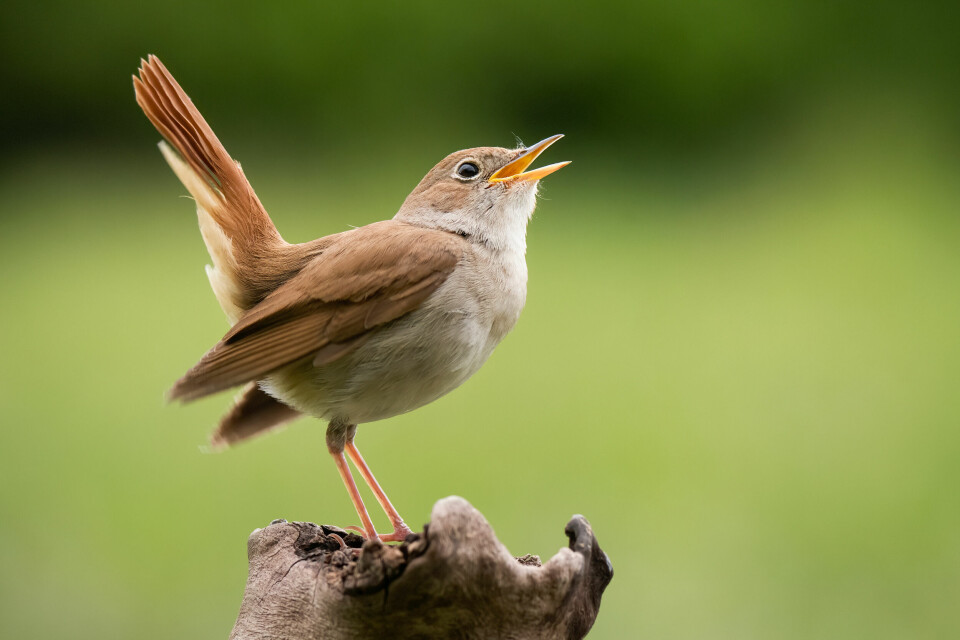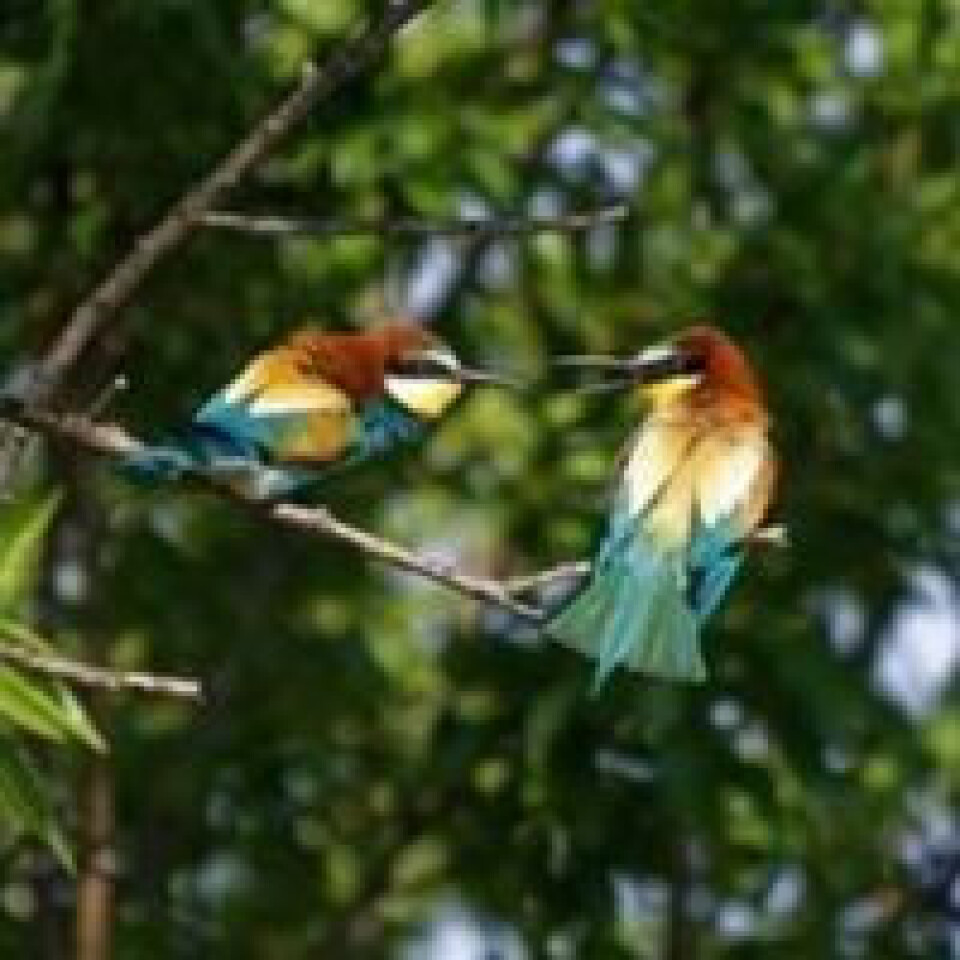-
Duck Cold! Four French phrases to use when it is freezing outside
We remind you of French expressions to use to describe the drop in temperature
-
When and why do we say le moral dans les chaussettes?
We explore this useful expression that describes low spirits
-
The origins and meaning of tirer les marrons du feu
As Christmas approaches, we look at a phrase to describe someone who takes advantage of a situation
Song birds in France and how to recognise their tune
Bird watcher Jonathan Kemp offers tips on spotting species by their song

There is a bird that delights our ears in Spring. Its nesting territory not 10 metres from the bedroom window; I hear it often; it is also a bird that I hardly ever see: The common nightingale (Fr. Rossignol philomèle).
Shy nightingales sing through the night

Common nightingale Photo: M.Fernandez
This mythic bird (although it would never have sung in Berkeley Square, just not the sort of place that you would find a nightingale), is a master at hiding itself on the other side of a hedge whilst pouring out its extraordinary song.
I have been standing no further than two metres away of a cascade of beautiful notes but know only too well if I dare to peer round the corner of a bush it will immediately stop, and the best I will get is a fleeting glimpse of little brown bird with a reddish tail disappearing rapidly into the undergrowth.
Birders call it ‘skulking’, which about sums it up.
It can be frustrating, if you want to see one... but they are more than forgiven for the beauty of the song.
And, yes, those of you who live in the French countryside know perfectly well that it lives up to its name and will serenade throughout the night.
This was when I first heard it, whilst sleeping out under the trees on a journey north, and it was so loud I couldn’t sleep.
Even though, at the time, I knew very few bird songs (and still don’t, compared to some), I knew it immediately for what it was; it just had to be.
Repeated clocking sound
Near us I have counted up to six males counter singing against each other, and this can actually be the dominant bird song at the right time of year.
The structure of the song is complex – I have read that there can be up to 400 different phrases in a mature Nightingale repertoire.
This is the kind of fact that only a scientist can come up with by using pictorial evidence of a sonogram, which translates sound into visual patterns.
However, there are certain simple phrases that are typical and unmistakable, especially a fluty, repeated clocking sound that once learnt is easy to remember.
Imitation game
Beware, I have just heard a nightingale imitating a chaffinch (Pinson des arbres), the sheer power of its song being the giveaway, and every now and then it would slip in some typical nightingale notes.
This bird’s abundance here is misleading, the decline in the UK is dramatic and is happening here in France too.
It is mainly due to loss of suitable habitat. Apparently the Knepp estate near Horsham is one of the few places in the UK where numbers of this wonderful songster are increasing.
Bee-eaters make ‘pruut’ sound

Bee-eaters Photo: Michel Fernandez LPO de l’Aude
Maybe you have heard a flock of bee-eaters (Fr. Guêpier d’Europe) passing over you, perhaps on migration; their call is a sort of rolling ‘pruut’, fairly high-pitched, and they travel in loose flocks calling to each other as they circle around, feeding on the wing.
Looking up it is possible to recognise the sharp pointed wings, even the wonderful bright colours unless masked against the bright sky.
They nest in colonies, neat holes dug in suitable soil of banks of rivers and even field margins (kingfishers dig similar holes, but always on waterways, as do sand martins).
Perch on telephone lines
However, it is when bee-eaters perch, sometimes on telephone wires, that you have a chance to marvel at their extraordinary coloured plumage.
If you are driving and you spot possible bee-eaters sitting on a line, don’t get out of the car; they – and most other bird species – will not accept a walking human being too near, but may accept a stationary car at a reasonable distance.
There are twenty-seven species of bee-eater in the world, and it would be a dream task to see them all – they are nearly all brightly plumaged like our European species.
Eat bees without getting stung
Yes, they do eat bees (Fr. abeilles) and thus are not popular with bee keepers, but they also eat other large insects such as hornets (Fr. frelon), wasps (both of which also predate on bees), locusts and dragonflies.
Their remarkable eyesight enables them to spot a flying insect 100 metres away, and they have evolved a special way of avoiding being stung by their prey.
Catching an insect whilst on the wing, they, if it has sting, will fly back to a perch and whack it on the branch with their turned down beaks and then rub the insect to squeeze out the venom.
Do not raid bee hives
However, unlike Honey-buzzards (Fr. Bondrée apivore) they do not raid bee hives or wasp nests and devour the larvae, so in reality the amount of damage they inflict upon a healthy colony of bees – upwards of 40,000 strong, with the worker bees only living for three weeks or so – can be considered to be marginal.
Patience pays off
Recently I have been spending quite a few hours searching for activity, either around our vulture sites, or just at places where I know I have a reasonable chance to see something that is a little out of the ordinary, but often to no avail, and time can drag by.
It’s the price you have to pay if you have a passion and, in a way, you make your own luck, and will be eventually rewarded by whatever it is you are looking for.
But sometimes, completely out of the grey on this cloudy day, you are given a gift.
I had been working outside all day, was happy to come to the end of the afternoon, cleared up and walked into the house.
I realised that I had forgotten my phone outside and as I went to fetch it, I heard the strangest of avian noises coming my way.
Sparrowhawk chased away
There was a Sparrowhawk (Fr. Epervier d’Europe) being pursued by two much smaller birds, Wrynecks (Fr. Torcol fourmilier).
There has been a male calling around the garden for the last few days and they came from the area in the wood where I hear them.
Too early in the nesting year for the hawk to have actually caught a fledgling, the wrynecks pursued her (quite a large bird, thus a female) out of range and came back.

Sparrowhawk Photo: Jonathan Kemp
The photo above is of a female sparrowhawk ‘mantling’ – covering its prey to protect it from others who might scavenge, a behaviour it would have learnt in the nest in competition with its siblings.
You will recognise more birdsong each year
A word about bird song.
It might be daunting; how to discriminate the various song colours all mixed together, like an orchestra tuning up – they are, after all, only interested mainly in others of their own species, but there are lots of aids on the internet.
Just start with the simplest ones you hear daily, hopefully seeing the bird at the same time.
I am not actually very good at it, but do notice that every year I might gain a few more, and it does get easier.
It’s a relief not to have to peer amongst the leaves, and simply let the ears do the work.
Related articles
New measures brought in after seagulls die of bird flu in Normandy
Nature watch: rescue vulture released in France, brown bear too ‘tame’
French crowing cockerel owner in court after neighbour’s complaint
























